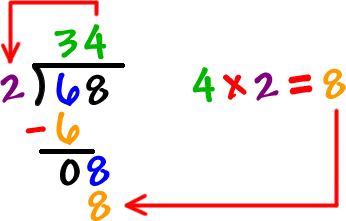HOW ON EARTH CAN A NUMBER BE FRIENDLY?
This week I'm going to dive into a topic that really intrigues me. In elementary school, I was beyond blessed to have teachers early on who DRILLED us on math facts, and it was something that came pretty easily to me. Because of that, when it came time for long division, I was excited to move on to what I thought was such "grown-up math" (3rd grade me had apparently never heard of calculus and was oblivious to the pain it would bring me in undergrad) 😅

Division was one of those things that I just felt comfortable with, and when I started working in a school, I felt really prepared to work with kids on division. Little did I know that they use a funny strategy now called partial quotients using "friendly numbers." At first, I was super skeptical of this method of division. It seemed like another one of those math things that they're having kids now do in 10 steps when it only takes 5. I was frustrated at the time it took and felt it was unnecessary untiiiiiiiillllll...
I was teaching a math module on division and one of my kids was in tears because while they understood how division works, they were having a hard time figuring out what numbers to use. We decided to use friendly numbers to help him.
You start by listing your "friendly numbers" which are basically just numbers that are "easy" facts. The friendly numbers are:
1
2
5
10
20
50
100
For some students, this is enough, but for others they continue by writing (x the divisor) next to each number. For example, if my problem was 125 divided by 5, I would write
1 x 5 = 5
2 x 5 = 10
5 x 5 = 25
10 x 5 = 50
20 x 5 = 100
50 x 5 = 250
100 x 5 = 500
They can refer back to these facts while dividing to help them choose a number to use. As students use the facts, they make sure to write the friendly number that they used to the right of the division problem. At the end, they add up the friendly numbers that they used, and that's their answer! This method definitely takes a bit more time and can add some steps, yet can be such a valuable scaffold for helping students who aren't as strong with their math facts get familiar with them and practice long division.

Here's a great blog that goes over this method in detail with suggestions for an interactive notebook for students to practice: https://jenniferfindley.com/easy-breezy-division-lots-of-freebies/

Division was one of those things that I just felt comfortable with, and when I started working in a school, I felt really prepared to work with kids on division. Little did I know that they use a funny strategy now called partial quotients using "friendly numbers." At first, I was super skeptical of this method of division. It seemed like another one of those math things that they're having kids now do in 10 steps when it only takes 5. I was frustrated at the time it took and felt it was unnecessary untiiiiiiiillllll...
I was teaching a math module on division and one of my kids was in tears because while they understood how division works, they were having a hard time figuring out what numbers to use. We decided to use friendly numbers to help him.
You start by listing your "friendly numbers" which are basically just numbers that are "easy" facts. The friendly numbers are:
1
2
5
10
20
50
100
For some students, this is enough, but for others they continue by writing (x the divisor) next to each number. For example, if my problem was 125 divided by 5, I would write
1 x 5 = 5
2 x 5 = 10
5 x 5 = 25
10 x 5 = 50
20 x 5 = 100
50 x 5 = 250
100 x 5 = 500
They can refer back to these facts while dividing to help them choose a number to use. As students use the facts, they make sure to write the friendly number that they used to the right of the division problem. At the end, they add up the friendly numbers that they used, and that's their answer! This method definitely takes a bit more time and can add some steps, yet can be such a valuable scaffold for helping students who aren't as strong with their math facts get familiar with them and practice long division.

Here's a great blog that goes over this method in detail with suggestions for an interactive notebook for students to practice: https://jenniferfindley.com/easy-breezy-division-lots-of-freebies/
Hey Danielle,
ReplyDeleteJust like you I was skeptical about using friendly number with long division. While I like some of the new strategies they are using in math I agree that sometimes it takes the students longer to complete the problem when it could be done in such a simpler way. I do like that students can use this friendly number strategy when they are having a hard time figuring out what to do next in the problem that in front of them. I checked out the line your provided and I love how the blog is engaging , helpful and colorful. I like the different examples of interactive student notebook because this could be another way to assess and evaluate if your methods and style of teaching the material is working. Thanks for all the useful information. Nice Job Danielle!!!